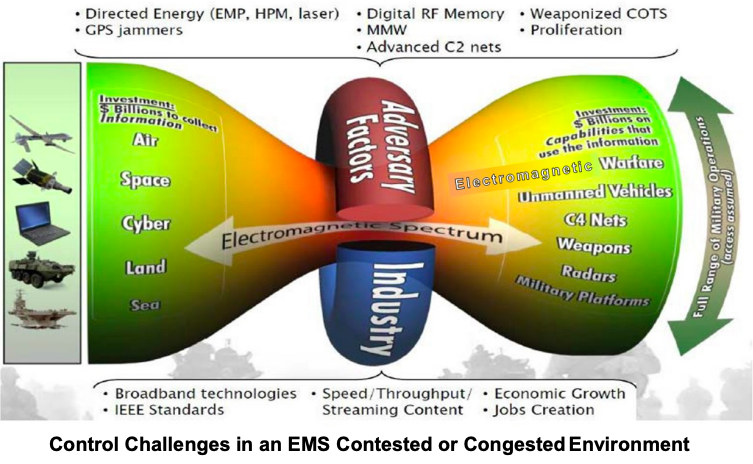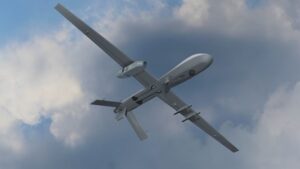By THERESA HITCHENS

WASHINGTON: Putting DoD’s new electromagnetic spectrum strategy into action will require overhauling how electronic warfare systems are developed and bought, senior DoD and service officials say. This includes ensuring that EW systems are compatible with radios, radars and other spectrum-reliant devices being used on the battlefield.
“I have some experience in in the challenges of that, because I come from an EW community where we’ve had spectrum conflicts with comms users and radar users and other spectrum-using systems,” DoD Director of Electronic Warfare David Tremper told a Mitchell Institute webinar today.
“Historically, we have not taken a holistic approach to how we manage spectrum-using systems tactically,” he explained. “We end up in these ‘cylinders of excellence’ where the EW community is trying to accommodate the radio community or vice versa. Or there’s finger pointing about who’s responsible for different spectrum issues. But there has never been historically a holistic view of that — how to deconflict that on the fly.”
Changing this will first require a new approach to investment across DoD and the services that focuses directly on how platforms and weapon systems are using spectrum, Tremper said. This will allow the services to leverage common approaches and technologies. But just as importantly, it also will ensure that subsystems for intelligence, surveillance and reconnaissance (ISR), communications and EW don’t interfere with each other.

Lockheed Martin’s Silent Crow cyber/electronic warfare pod on an Army MQ-1C Grey Eagle drone. (Lockheed illustration)
“When you build an EW system, you’re not building an airplane, or you’re not building a submarine or you’re not building a ground system. You’re building a system that’s capable of using the RF spectrum in a particular way,” he said.
DoD published its first Electromagnetic Spectrum Superiority Strategy on Oct. 29, a high-level document light on specifics that sets out principles and goals. The bottom line, as Sydney reported, is that the Pentagon is trying to devise a way to wage precision electronic warfare that uses artificial intelligence, signals intelligence and cyber warfare to deceive and disrupt enemy transmissions. That requires merging the traditionally separate disciplines of electronic warfare (i.e., jamming enemy frequencies) and spectrum management to efficiently allocate frequencies among friendly forces into what DoD now calls ‘electromagnetic spectrum operations,’ or EMSO. Development of an implementation plan is being led by the led by the Electromagnetic Spectrum Operations Cross Functional Team, led by Vice-Chairman of the Joint Chiefs of Staff Gen. John Hyten.
One of the most important changes embedded within the new strategy is the mandate to use open software standards and the development of a “central systems architecture” based on them, explained Ilya Lipkin, who heads the Air Force Life Cycle Management Center’s (AFLCMC) Steering Committee for the Sensor Open Systems Architecture (SOSA) Consortium. SOSA is a public-private expert group “creating open system reference architectures applicable to military and commercial sensor systems” that “employ modular design and use widely supported, consensus-based, nonproprietary standards,” according to the group’s website.
“In particular, we all recognize the growing importance of open architecture standards for ensuring that our systems capabilities, components and technologies can talk to one another, together and seamlessly as possible, to achieve compatibility and reduce the sustainment costs,” he told the webinar.
Open standards and open architectures for software-defined, multifunction subsystems that can be swapped out among different platforms for different uses also are critical to ensuring that EW capabilities can keep up with fast-changing threats, Tremper said. “Software defined, multifunction systems allow you to accelerate EW capabilities,” he said. “I can sling some new code and I can put it into that box and have that new capability as fast as the threat shows up.”
But ensuring that these software-based capabilities are compatible across the Army, Navy, Air Force and DoD writ large will require that individual development programs are actually using the same, or at least compatible standards. And that isn’t as easy as it sounds, Tremper said.
NC3 is “the last line of communication capabilities and associated equipment that we know will always be there during our worst day,” explains Air Force Lt. Gen. James Dawkins, deputy CSAF for strategic deterrence and nuclear integration.
Tremper said that currently, there is no coherence to how compliance with such standards is ensured. Even within the individual services there often are multiple program executive officers (PEOs) with each managing a different EW development program.
“I can tell you from my history with modular open architectures, and open standards, that one of the challenges that we have here is our ability to work across the various programs and the PEOs, to get them all consolidated and how we how we move forward that together,” Tremper said. “There is no linchpin there to say thou shalt use these standards, thou shalt use these architectures.”
The trick will be finding the balance between putting the authority for standards implementation too high up in the acquisition management chain — where the detailed oversight becomes impossible — or too far down the chain, where a change of program manager can result in abrupt shifts in how standards are interpreted, he elaborated.
The fix may be to establish service-level PEOs for spectrum (not for programs) as the action officers charged with ensuring compliance with standards set at OSD level, he said. One advantage of taking this approach would be that these functional PEOs would be technically savvy enough to ride herd on contractors to ensure that proposed solutions are truly open. Often, when setting the standards is left solely up to industry, “when you dig in, you find that: ‘Oh, you know what, there’s a pin here that’s proprietary’,” he explained. “And so despite the use of open and standard architectures, when I really dig in on a design, I discover it’s actually a proprietary system.”

The Electronic Warfare Planning and Management Tool will enhance the ability to plan, coordinate, and synchronize electronic warfare, spectrum management, and cyber operations.
As for actually wielding EW capabilities on the battlefield, Strategic Command (STRATCOM) now has responsibility for that under the Unified Command Plan for Joint electromagnetic Spectrum Ops (JEMSO), per the May-issued “JP 3-85, Joint Electromagnetic Spectrum Operations” doctrine. This “means we are the support mechanism for joint planning, training and advocacy,” Air Force Brig. Gen. AnneMarie Anthony, STRATCOM’s deputy director of Joint EMS Operations (JE-3), told the webinar.
STRATCOM already has a three-pronged effort underway to build up a skilled EW workforce and the tools they will need to deal with adversary efforts to disrupt US military access to spectrum during conflict. “As everyone here is aware, the electromagnetic operational environment is becoming more complex — you know, think contested, congested and constrained,” she said.
The first initiative is the development of a Joint Electromagnetic Spectrum Operations Cell, or JEMSOC, she said. “That’s the people: the people at the joint level that will do the mission. And it’s the goal to have a JEMSOC for each of the combatant commands .”
The second is development of an automated Electromagnetic Battle Management (EMBM) system for planning and controlling EW activities in the field. “This is the tool that the JEMSOC will use to do joint planning, situational awareness, and command and control,” Anthony explained.
“We are using a rapid software acquisition process to develop this tool,” she added. “So think: minimum viable product releases. It will feature cloud-based data tools and machine-to-machine and human-to-machine interaction. We are at the very beginning of this effort and it is very exciting. STRATCOM will be the operational sponsor, and DISA [the Defense Information Services Agency] is the program manager for this effort.”
Finally, there is the Joint EMF Information Analysis and Fusion effort, which is an initiative to build up an integrated data lake for use by the EMBM, Anthony said. STRATCOM’s Joint Electromagnetic Warfare Center in San Antonio “is building this using Amazon Web Services,” she explained.
No comments:
Post a Comment